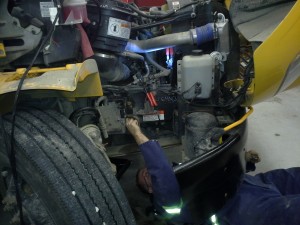This is a 2006 Thomas C2 school bus that had a park brake that would not release. The video shows the AMU air management unit that controls the PB circuit. When releasing the park brake the switch sends a signal to the bulk head module which is the brains of the operation allowing the PB to release.
Over the years we have changed several of these switches and brake light switches. they both sense pressure to open or close an internal switch and sometimes the contacts are not connecting properly for a closed circuit. To release the park brake the foot brake has to be applied first similar to a car to shift an automatic transmission into gear. This is a safety feature to prevent vehicle rollaway while in gear.
Troubleshooting
There are simple checks you can make when troubleshooting the park brake release problem to determine which component is faulty. The first check to make is with the brake lights to see if they are on. Check for blown fuses supplying the chassis hub module and expansion module in the chassis PDM (power distribution module mounted on the driver’s side fender).
Check battery voltage to each chassis and expansion module. Check the AMU module A (the end one on the driver’s side) for ground on circuit #36 pin C. Pin D should have a constant ground. Jumping pin C to D in the harness should activate the brake lamps and release the park brake. If it does the AMU module A is faulty.
If the brake lights are working but the park brake is still not releasing the next step is to test the park brake switch. The park brake indicator should be illuminated on the dash when applied. If not follow the steps I took in the video to test the circuit by jumping the 2 terminals at the PB switch plug that’s disconnected. If the park brakes release and the indicator light comes on the PB switch is faulty.
Multiplexing
Multiplexing is involved with the brakes not releasing with signals being transmitted from the expansion/chassis hub module which relays signals from the bulkhead module to operate all of the components. The expansion and chassis hub module is located under the cab and frame and if problems happen the connectors need to be pulled out and inspected.
If corrosion or moisture is present the connectors can be cleaned with Penlube or any other type of contact cleaner. Our shop likes Penlube because of the way it totally blocks out moisture. A lot of times this has been the issue since the module is located in an area that’s vulnerable to the environment.
Over the years since 2006 the electrical issues have given us the experience to know where to look. At first it was a challenge starting with finding schematics and locating the problem. Many times the wiring was corroded or there was a corrosion build up at a module connector.







